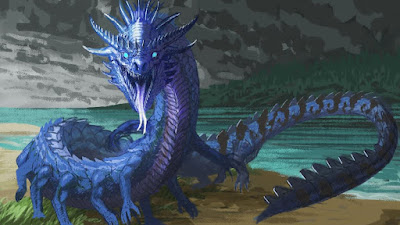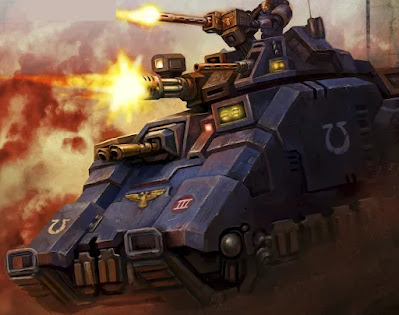 |
Yeah that's a pretty terrible picture of him
|
Back in Hommlet our heroes rest and prepare for another expedition into the dungeon beneath the Moathouse. Our Heroes:
Braeden (Human Ranger)played by Battletech TerrySir Kentor (Human Paladin) played by Paladin SteveSir Lantor (Human Fighter) played by Boom Gun BrandonXyzzifax (Human* Wizard) played by BlasterSamson (Halfling Mechanist) played by Shootist WillJaric (Human Cleric) played by Variable David All are level 2 or 3 at this point. Grognard Mike is out this week so Malice is hanging out in Hommlet and Inigo the Rogue is also absent - as he often is)
The much more entertaining players account, written in-character again "As told by the Illustrious and Mighty Xyzzifax" is here.
The Ranger and Cleric head to the Temple of St. Cuthbert seeking holy water and information. They acquire the holy water and then meet with Terjon to discuss the symbol they found on the guards/bandits/armed hostile humans in the last expedition (The Flaming Eye). Terjon knows a little about about the organization of the temple and explains that while theoretically unified under "Elemental Evil" the four major factions compete with and seek dominance over one another. He also mentions that they have always sought to control the lands around the temple as well and so are probably building an army.
The rest of the party makes some minor purchases and checks in on friends. Samson constructs a crossbow that can be attached to Lantor's arm & armor giving him an easier ranged option when called for as having to swap between a crossbow and his greatsword has been tricky for him. Samson is happy to help and Lantor is happy to have it.
After two days in Hommlet the team returns to the Moathouse and heads down to check out some of the areas they did thoroughly explore before. Spotting a pair of bugbears via the Miraculous Recon Owl they start a pretty serious discussion about how to proceed as the bugbear fight (see Session 6) was a tough one and they do not want to end up fighting the human cultists from last session and the bugbears at the same time, possibly being cut off by one or the other. They end up deciding to have the mage wizard-lock the door to the cult area first and then go back and deal with the bugbears. It's a solid plan - shame it didn't work.
Most of the party hangs back while the Braeden and Xyzzifax sneak up towards the cultist door and I will transition here to the first-person account:
The recently promoted Minion #3, Braeden, accompanies Xyzzifax, to provide support. The Ranger loses all recently gained respect, and falls in the rankings to minion #4, when he fails to spot a noise trap, a tripwire is triggered, causing a cascade of scrap metal to fall, with the clanging and crashing echoing through the dungeon. The pair’s presence is now surely known.
Xyzzifax ceases all pretense of stealth, spreading his wings, and launching himself into the air to cover the remaining distance to the door. Upon reaching it, he immediately begins to chant, casting his arcane lock spell on the door, betting that he can resolve his spell before the guards open the door. 36 seconds later, 4 cult guards fling the door open, brandishing crossbows! All four loose bolts at the chanting wizard, yet arcane shields spring forth, and all four bolts fall harmlessly to the ground. Combat ensues!
Yes, the all-about-perception-and-sneaking ranger blows a check and snags a tripwire and blows the entire plan to hell! This turns into a pretty serious fight with eight guards including another leader type who does not go gently.
After this the mage tries to wizard lock the door again and is again interrupted by more guards who kick the door open and start another fight! They push these guards back, heal up, and decide to push on into the cult lair.
Passing through the second door (now safely wizard locked as well) they encounter a third door and pick the lock, open the door, and immediately encounter the cult guards and leaders waiting for them with spells and weapons readied. The cult leader orders his men to kill the party and the battle is on.
Kentor, Lantor, and Samson all take a good beating - which is becoming pretty normal. Samson drops at least once and Lantor gets Held when Lareth the cult leader manages to get a spell off and then later gets Blinded. Xyz invokes a flaming sphere which is also becoming a pretty standard tactic for him. Eventually Lareth is the last bad guy standing and finally drops as the entire party lays into him. The party gets a ton of loot from this including +1 plate, a Staff of Striking, and a Ring of Free Action, all of which will prove to be a thorn in my side for the future.
 |
| Definitely better with the helmet on |
DM Notes:
This was the big finale for the Moathouse and ended with an appropriately spectacular battle that they kind of stumbled into. That last fight went about 5 rounds and they fought Lareth, 2 guard captains, 11 guards, and a Cult Fanatic. With spells going off on both sides, some vicious melee engagements, and at least one PC dropping, it felt like a pretty dangerous fight. Certain trends are emerging:
- The Ranger is the sneaking specialist who mostly fights at range with his bow, jumping into melee when one of the fighters drops. He's very much a pragmatist and rolls with whatever comes the party's way.
- The Cleric started off as the healing guy but has moved into more of a combat role as the game has gone on. He usually opens with Spiritual Weapon and goes from there. Now he has the Staff of Striking and will quickly develop into the Kill-Stealing Cleric as he wades into battle and clocks somebody already wounded with a triple-charge staff strike and blows them into vapor. Yes, it is annoying. Yes, the player is eating it up.
- The Fighter is not really a glass cannon but he does tend to be the one who drops in most fights. He's armored up but he uses a two-hander so he cannot use a shield and that means of the melee types he has the lowest AC. He also is the youngest player and tends to charge into a fight in round one regardless of what the rest of the party is doing so he ends up surrounded and gets pounded on first and most. As the campaign goes on this continues but he does work on upping his armor class so it gets a little better.
- The Paladin is the experienced melee combatant who is taking all of the "tanking" type abilities that he can. Most of these punish an enemy for not striking him, as in giving them a negative modifier or giving him a free attack. He is very conscious of his AC and wants it to be the highest in the party - and it usually is, barring some spell going off. Also Smite is a devastating thing and he is very good at choosing his moment of glory to use it. He's still being played as Lawful Good even with alignment not being in the game and his loyalty to the party is unquestionable.
- The Mechanist is an interesting new type of character. He doesn't cast spells but he can buff his party (including himself) with various gadgets and enhancements to equipment. Here the paladin is carrying a hammer enhanced with a +1 and "returning" to give him a good opening ranged attack. The fighter now has a light crossbow built into his armor keeping his hands free for melee.
Samson is also good as a skill monkey focused in on detecting traps and picking locks - any gadget-related thing he is unstoppable. Also, he can basically "Identify" magic items by touch. This is also pretty annoying at first as a DM because that whole sub-section of the game of figuring out what an item can do has been part of the fun for a long time and this just eliminates that entirely. It does get to be fun later when they find a cursed item though so it's not entirely one-sided. There have also been many jokes about "hey, bring your magic hands over here ..." - Xyzzifax - the wizard has been the real revelation here. He speaks in an immediately identifiable voice, he has questionable morals, some fuzziness on party loyalty, and often refers to the other characters as "minions", sometimes ranking them on the fly. Game-wise he is powergaming the shit out of ToV's wizard options and showing me just how ridiculous they can be at maximum effort which I suppose I deserve since he is my kid. The familiar rules are very lenient and he has used them ruthlessly to make mapping the dungeon and recon in general a very low-effort undertaking for them. He knows his spells like a pro and knows when to cast them, when to use a wand, and when to just go with Ye Olde Firebolt. He is also not averse to jumping into a fight up close when needed, made easier with his built-in wings (He's a ToV "Beastkin" lineage, which gives a fair number of options to cover a variety of animals, one of which is wings & flight = to your walking speed). That said, he is also quick to jump out of combat when hit with anything significant as he is fairly concerned with his own skin.
It's been a lot of fun up to this point and it only gets better.

































